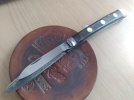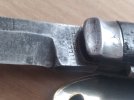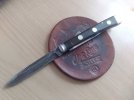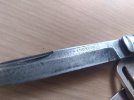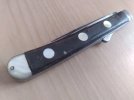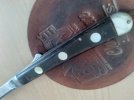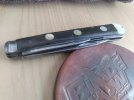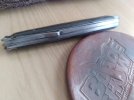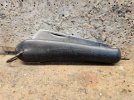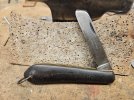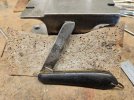wlfryjr
Gold Member
- Joined
- Oct 20, 2011
- Messages
- 1,980
Thanks Will.Harry Brearley, the inventor of stainless steel, wrote extensively about his discovery, both in his autobiography Knotted String, and elsewhere. His writings shine a fascinating light on the workings of the Sheffield factory system, and the individuals who ran those factories. Brearley discovered stainless in 1913, and the first stainless knives were made by Robert (R.F.) Mosley the same year. Knife-blades were still being hand-forged in Sheffield at this time, and understanding that the new steel needed very particular and exact HT, Brearley recommended that Firth's, whose employ he had been in when discovering its stainless properties, recommended that the steel only be supplied already heat-treated. He was ignored by his former employer, who without his knowledge (as joint patent-owner) sent out samples to half a dozen of Sheffield's biggest cutlery factories. These included Rodgers and Wostenholm, but also Ibberson, who claimed to be the first firm to use stainless for pocket knives. According to Brearley, folding knives were made from it prior to WW1 (1914-18). The manufacturers used various names to describe the new steel, but it was supposed to be marked 'Firth-Brearley Stainless'. Firth's quickly reneged on this, calling it 'Firth Stainless', and while a legal action by Brearley forced them back in line, they again reneged later. Here are a few examples of early stainless knives, with their various stamps and etches. Please excuse the poor quality of the old photos
The less common Firth-Brearley Stainless mark, the last example can be dated exactly to 1935.
We are commonly told that the early stainless wasn't very good, or that it wouldn't hold an edge, and it's true that the Sheffield cutlers, for the most part, preferred to continue to use carbon steel. However, the Sheffield factory owners, during this period, were often both lazy and stupid, and clearly didn't understand that different HT methods were needed. More importantly, the cutlers didn't like it, and didn't want to work with it. When you understand that most Sheffield cutlers were effectively self-employed, on 'piece-work', and had to buy their own tools, this is entirely understandable, because working stainless was much harder on their tools than carbon. Stan Shaw has told me about the early opinions of the cutlers he worked with, saying that the early stainless could wear a file in no time. "It were hard as glass."
Another "farmers whittler" from another high end UK retailer. Clements early stainless, etched Stainless Throughout.


